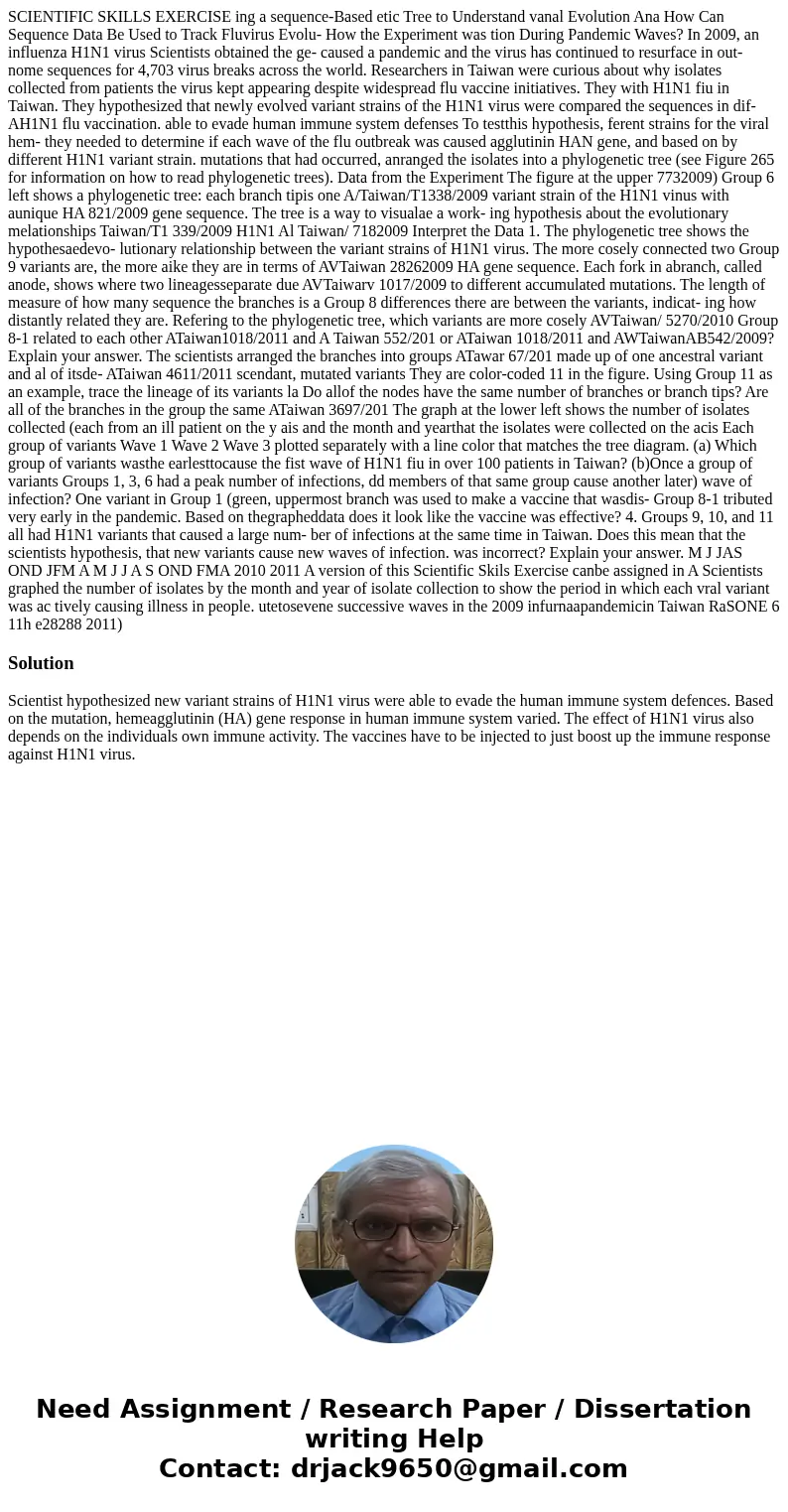SCIENTIFIC SKILLS EXERCISE ing a sequenceBased etic Tree to
SCIENTIFIC SKILLS EXERCISE ing a sequence-Based etic Tree to Understand vanal Evolution Ana How Can Sequence Data Be Used to Track Fluvirus Evolu- How the Experiment was tion During Pandemic Waves? In 2009, an influenza H1N1 virus Scientists obtained the ge- caused a pandemic and the virus has continued to resurface in out- nome sequences for 4,703 virus breaks across the world. Researchers in Taiwan were curious about why isolates collected from patients the virus kept appearing despite widespread flu vaccine initiatives. They with H1N1 fiu in Taiwan. They hypothesized that newly evolved variant strains of the H1N1 virus were compared the sequences in dif- AH1N1 flu vaccination. able to evade human immune system defenses To testthis hypothesis, ferent strains for the viral hem- they needed to determine if each wave of the flu outbreak was caused agglutinin HAN gene, and based on by different H1N1 variant strain. mutations that had occurred, anranged the isolates into a phylogenetic tree (see Figure 265 for information on how to read phylogenetic trees). Data from the Experiment The figure at the upper 7732009) Group 6 left shows a phylogenetic tree: each branch tipis one A/Taiwan/T1338/2009 variant strain of the H1N1 vinus with aunique HA 821/2009 gene sequence. The tree is a way to visualae a work- ing hypothesis about the evolutionary melationships Taiwan/T1 339/2009 H1N1 Al Taiwan/ 7182009 Interpret the Data 1. The phylogenetic tree shows the hypothesaedevo- lutionary relationship between the variant strains of H1N1 virus. The more cosely connected two Group 9 variants are, the more aike they are in terms of AVTaiwan 28262009 HA gene sequence. Each fork in abranch, called anode, shows where two lineagesseparate due AVTaiwarv 1017/2009 to different accumulated mutations. The length of measure of how many sequence the branches is a Group 8 differences there are between the variants, indicat- ing how distantly related they are. Refering to the phylogenetic tree, which variants are more cosely AVTaiwan/ 5270/2010 Group 8-1 related to each other ATaiwan1018/2011 and A Taiwan 552/201 or ATaiwan 1018/2011 and AWTaiwanAB542/2009? Explain your answer. The scientists arranged the branches into groups ATawar 67/201 made up of one ancestral variant and al of itsde- ATaiwan 4611/2011 scendant, mutated variants They are color-coded 11 in the figure. Using Group 11 as an example, trace the lineage of its variants la Do allof the nodes have the same number of branches or branch tips? Are all of the branches in the group the same ATaiwan 3697/201 The graph at the lower left shows the number of isolates collected (each from an ill patient on the y ais and the month and yearthat the isolates were collected on the acis Each group of variants Wave 1 Wave 2 Wave 3 plotted separately with a line color that matches the tree diagram. (a) Which group of variants wasthe earlesttocause the fist wave of H1N1 fiu in over 100 patients in Taiwan? (b)Once a group of variants Groups 1, 3, 6 had a peak number of infections, dd members of that same group cause another later) wave of infection? One variant in Group 1 (green, uppermost branch was used to make a vaccine that wasdis- Group 8-1 tributed very early in the pandemic. Based on thegrapheddata does it look like the vaccine was effective? 4. Groups 9, 10, and 11 all had H1N1 variants that caused a large num- ber of infections at the same time in Taiwan. Does this mean that the scientists hypothesis, that new variants cause new waves of infection. was incorrect? Explain your answer. M J JAS OND JFM A M J J A S OND FMA 2010 2011 A version of this Scientific Skils Exercise canbe assigned in A Scientists graphed the number of isolates by the month and year of isolate collection to show the period in which each vral variant was ac tively causing illness in people. utetosevene successive waves in the 2009 infurnaapandemicin Taiwan RaSONE 6 11h e28288 2011) 
Solution
Scientist hypothesized new variant strains of H1N1 virus were able to evade the human immune system defences. Based on the mutation, hemeagglutinin (HA) gene response in human immune system varied. The effect of H1N1 virus also depends on the individuals own immune activity. The vaccines have to be injected to just boost up the immune response against H1N1 virus.

 Homework Sourse
Homework Sourse